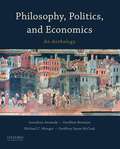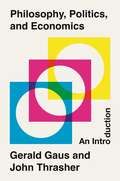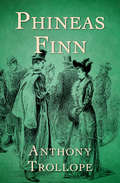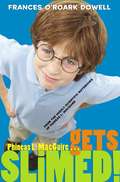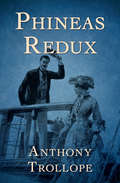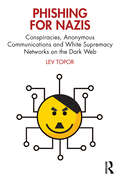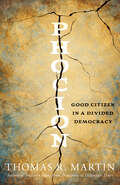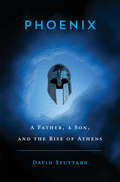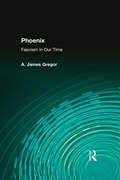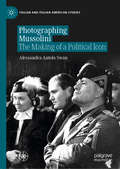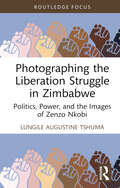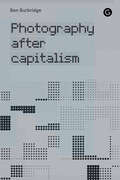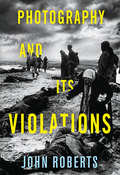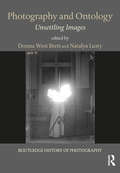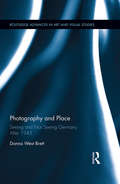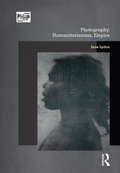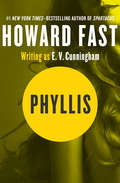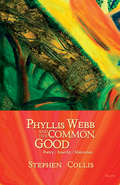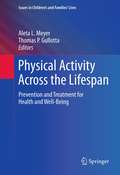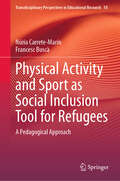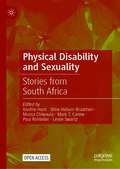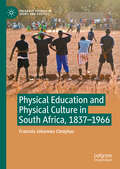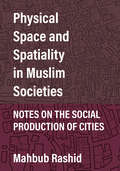- Table View
- List View
Philosophy, Politics, And Economics: An Anthology
by Michael C. Munger Jonathan Anomaly Geoffrey Brennan Geoffrey Sayre-MccordThe only book on the market to include classical and contemporary readings from key authors in Philosophy, Politics, and Economics (PPE), this unique anthology provides a comprehensive overview of the central topics in this rapidly expanding field. Each chapter opens with an introduction that helps students understand the central arguments and key concepts in the readings. The selections encourage students to think about the extent to which the three disciplines offer complementary or contradictory ways of approaching the relevant issues. Philosophy, Politics, and Economics: An Anthology is ideal for undergraduate PPE programs and courses in political philosophy and political economy.
Philosophy, Politics, and Economics: An Introduction
by Gerald Gaus John ThrasherAn updated and expanded edition of the classic introduction to PPE—philosophy, politics, and economics—coauthored by one of the field’s pioneersPhilosophy, Politics, and Economics offers a complete introduction to the fundamental tools and concepts of analysis that PPE students need to study social and political issues. This fully updated and expanded edition examines the core methodologies of rational choice, strategic analysis, norms, and collective choice that serve as the bedrocks of political philosophy and the social sciences. The textbook is ideal for advanced undergraduates, graduate students, and nonspecialists looking to familiarize themselves with PPE’s approaches.Starting with individual choice, the book develops an account of rationality to introduce readers to decision theory, utility theory, and concepts of welfare economics and consumer choice theory. It moves to strategic choice in game theory to explore such issues as bargaining theory, repeated games, and evolutionary game theory. The text also considers how social norms can be understood, observed, and measured. Concluding chapters address collective choice, social choice theory and democracy, and public choice theory’s connections to voters, representatives, and institutions.Rigorous and comprehensive, Philosophy, Politics, and Economics continues to be an essential text for this popular and burgeoning field.The only book that covers the entirety of PPE methodsA rigorous, nontechnical introduction to decision theory, game theory, and positive political theoryA philosophical introduction to rational choice theory in the social sciences
Phineas Finn
by Anthony TrollopeSecond of the 6 Palliser novels, this is the story of an Irish M.P. who asks questions about honesty, independence and parliamentary democracy. Includes notes on the text.
Phineas Finn: The Irish Member, Volume 3 (The Palliser Novels #2)
by Anthony TrollopeAn adventurous Irishman sets out to find his fortune among proper English society in this classic novel from Anthony Trollope. Sent to London to become a lawyer, young Phineas Finn proves himself to be a disappointing student but truly gifted in the ways of charm, culture, and fine appearance. It is the discovery of these talents that ultimately leads him to what he believes is his true calling: English Parliament. Through sheer luck and pluck, dashing, innocent Phineas is able to win a seat on the bench, but the real journey begins as he tours the labyrinthine halls of those who hold sway over their fellow men—and the practical and romantic quandaries he must navigate if he is to advance himself. Finding both victory and defeat, love and loneliness, the path Phineas strides is one of confidence and humanity as he seeks to fulfill his wants and desires while holding true to his convictions both in his own life and in the ever-changing arena of political expediency. In Phineas Finn, Anthony Trollope invites readers to follow an irrepressible, good-minded protagonist in a comical, exciting, heartbreaking tale that resonates as much today as it did upon its first publication. Phineas Finn is the 2nd book in the Palliser Novels, but you may enjoy reading the series in any order. This ebook has been professionally proofread to ensure accuracy and readability on all devices.
Phineas L. MacGuire ... Gets Slimed!
by Frances O'Roark DowellPhineas L. MacGuire (a.k.a. Mac) has three goals for fourth grade: 1. To be the best fourth-grade scientist ever. 2. To be the best fourth-grade scientist ever. 3. To be the best fourth-grade scientist ever. It's a tall order, but he's confident that he can achieve it, especially since his friend and rival scientist, Aretha, has asked him to help her earn a scout badge by creating the mold that produces penicillin. After all, who knows more about mold than Mac? And how many fourth graders can say that they've reproduced penicillin? None, as far as Mac knows. But then he has to manage Ben's campaign for class president and deal with his new babysitter, Sarah Fortemeyer, "the Teenage Girl Space Alien from the Planet Pink" who accidentally got rid of his dried worm collection and now he has to find it. How is he supposed to find time to focus on mold? The second book about Phineas L. MacGuire and his scientific experiments, "Phineas L. MacGuire ... Gets Slimed!", is as much fun as the first, and includes slimy new experiments that you can do at home!
Phineas Redux: By Anthony Trollope, Volume 1 (The Palliser Novels #4)
by Anthony TrollopeThe ever-ambitious Irish rogue Phineas Finn is pulled back into the game of Parliamentary politics in this classic novel from Anthony Trollope. After his beloved wife dies in childbirth, a bored and restless Phineas Finn is compelled to seek out the never-ending war of will and words within the English Parliament. Still considered a promising prospect of the younger generation, he is welcomed back into the fold. Upon his return to London, Phineas renews his friendship with the wealthy widow Madame Max Goesler, whose offer of marriage he had once turned down. But he soon finds an enemy in Mr. Bonteen, who distrusts Phineas&’s loyalty to the party, and the two become harsh rivals. And when Bonteen is murdered, Phineas finds both his political fortunes and his very life in the balance. With his trademark humor and humanity, Anthony Trollope takes readers on another adventure full of heart and hope. As with the captivating Phineas Finn, Phineas Redux will have you rooting for this irrepressible protagonist all over again. Phineas Redux is the 4th book in the Palliser Novels, but you may enjoy reading the series in any order. This ebook has been professionally proofread to ensure accuracy and readability on all devices.
Phishing for Nazis: Conspiracies, Anonymous Communications and White Supremacy Networks on the Dark Web
by Lev ToporPhishing for Nazis is an evidence-based, undercover study of neo-Nazi communities on anonymous communication platforms that helps to shine a light on the dark web. It unveils how hatred and conspiracies spread and thrive online and how white supremacy is becoming prominent as extremists find shelter in the online dank underbelly of society. Phishing for Nazis explains how online manifestations of hate radicalize people into taking “real-world” action, such as shooting sprees. Methodologically, this book is unique, as it incorporates undercover cyberethnography, a method frequently used by law enforcement and intelligence agencies, unlike traditional academic studies of racism or social behavior that rely on secondary sources or surveys. With a particular interest on how race issues translate online, the book presents the true phenomenon of racism without relying on political correctness or whitewashing. It contributes to the field of cyber communication, as it details why and how people communicate and manage entire communities without knowing one another. The book also contributes to public policy, regulators, and technology companies as they deal with the practice of online anonymity and extremism.
Phocion: Good Citizen in a Divided Democracy (Ancient Lives)
by Thomas R. MartinThomas R. Martin recounts the unmatched political and military career of Phocion of Athens, and his tragic downfall Phocion (402–318 BCE) won Athens&’s highest public office by direct democratic election an unmatched forty-five times and was officially honored as a &“Useful Citizen.&” A student at Plato&’s Academy, Phocion gained influence and power during a time when Athens faced multiple crises stemming from Macedonia&’s emergence as an international power under Philip II and his son Alexander the Great. Following Athens&’s defeat by Macedonia, Phocion unsuccessfully sought mild terms of surrender. Oligarchy was imposed on democratic Athens, and more than twelve thousand &“undesirable&” Athenians were exiled. When the oligarchic regime was overthrown and the exiles returned, dispossessed Athenians took out their volcanic anger on Phocion, who throughout his career had often been a harsh critic of the citizens&’ political decisions. His inflammatory rhetoric contributed to the popular conclusion that he lacked a genuine sense of belonging to the community he wished so desperately to preserve. When he was eighty-four, the Athenians convicted him of treason and condemned him to die by hemlock. In this fresh biography, Thomas R. Martin explores how and why Phocion ultimately failed as a citizen and as a leader. His story offers unsetting lessons for citizens in democracies today.
Phoenix: A Father, a Son, and the Rise of Athens
by David StuttardA vivid, novelistic history of the rise of Athens from relative obscurity to the edge of its golden age, told through the lives of Miltiades and Cimon, the father and son whose defiance of Persia vaulted Athens to a leading place in the Greek world. When we think of ancient Greece we think first of Athens: its power, prestige, and revolutionary impact on art, philosophy, and politics. But on the verge of the fifth century BCE, only fifty years before its zenith, Athens was just another Greek city-state in the shadow of Sparta. It would take a catastrophe, the Persian invasions, to push Athens to the fore. In Phoenix, David Stuttard traces Athens’s rise through the lives of two men who spearheaded resistance to Persia: Miltiades, hero of the Battle of Marathon, and his son Cimon, Athens’s dominant leader before Pericles. Miltiades’s career was checkered. An Athenian provincial overlord forced into Persian vassalage, he joined a rebellion against the Persians then fled Great King Darius’s retaliation. Miltiades would later die in prison. But before that, he led Athens to victory over the invading Persians at Marathon. Cimon entered history when the Persians returned; he responded by encouraging a tactical evacuation of Athens as a prelude to decisive victory at sea. Over the next decades, while Greek city-states squabbled, Athens revitalized under Cimon’s inspired leadership. The city vaulted to the head of a powerful empire and the threshold of a golden age. Cimon proved not only an able strategist and administrator but also a peacemaker, whose policies stabilized Athens’s relationship with Sparta. The period preceding Athens’s golden age is rarely described in detail. Stuttard tells the tale with narrative power and historical acumen, recreating vividly the turbulent world of the Eastern Mediterranean in one of its most decisive periods.
Phoenix: Fascism in Our Time
by A. James GregorA great deal of effort has been expended by Anglo-American scholars in an attempt to isolate past and contemporary "fascisms", "neofascisms", "cryptofascisms" and "latent" fascisms in the modern world. A. James Gregor's "Phoenix: Fascism in Our Time" is an insightful history of the intellectual rationale for Benito Mussolini's fascism offered by major Italian intellectuals. The book provides a list of recurrent features that helps to identify the generic phenomenon. This lucid account reviews seriously neglected aspects of intellectual history, describing the socioeconomic and political conditions that precipitate and sustain fascism. Gregor shows that Italian fascism was supported by a responsible and credible rationale. His account of that rationale permits us to understand the appeal fascism as an ideal has exercised over elites and masses in the 20th century. Gregor offers a credible list of traits in showing how instances of fascism can be identified when they first appear. The last chapters of the work are devoted to a case study of the newly emergent post-Soviet Russian nationalism and its affinities with historic fascism. Gregor discusses the implications of the rise of generic fascism in the former Soviet Union and post-Maoist China. This timely volume offers an alternative to conventional interpretations of the major historical events of the 20th century. "Phoenix" is must reading for scholars and policymakers dealing with European history between the two world wars, and should will be instructive for anyone interested in the fascist ideology in a new millennium.
Photographing Mussolini: The Making of a Political Icon (Italian and Italian American Studies)
by Alessandra Antola SwanThis pioneering book offers the first account of the work of the photographers, both official and freelance, who contributed to the forging of Mussolini's image. It departs from the practice of using photographs purely for illustration and places them instead at the centre of the analysis. Throughout the 1930s photographs of the Italian dictator Benito Mussolini were chosen with much care by the regime. They were deployed to highlight those physical traits - the piercing eyes, protruding jaw, shaved head - that were meant to evoke the Duce's strength, determination and innate sense of leadership in the mind of his contemporaries. The chapters in this volume explore the photographic image in the socio-political context of the time and shows how it was a significant contributor to the development of Italian mass culture between the two world wars.
Photographing the Liberation Struggle in Zimbabwe: Politics, Power, and the Images of Zenzo Nkobi (Routledge Studies in the Modern History of Africa)
by Lungile Augustine TshumaAfter assuming power in 1980, the Zimbabwe African National Union (ZANU) has sought to control the narrative of the struggle for liberation from colonialism, to the exclusion of other players such as the Zimbabwe African People’s Union (ZAPU). This book investigates the ways in which photographs are being used within Zimbabwe, especially on social media, to challenge the prevailing narrative and reclaim the memories of the subjugated. The book analyses the photographs produced by Zenzo Nkobi during the struggle against colonialism. Drawing on the memories of veterans from ZAPU and its military wing the Zimbabwe People’s Revolutionary Army (ZPRA), the book shows that photographs can both act as a conduit for existing narratives, and as a tool for shaping memory narratives, and evidencing ZPRA military prowess ahead of other movements.At a time when Zimbabwe is reassessing the legacy of liberation, this book offers a powerful multidisciplinary assessment for researchers across the fields of history, memory, political science, African studies, and media studies.
Photography After Capitalism
by Ben BurbridgeA lively and polemical analysis of photography and today's vernacular photographic culture.In Photography After Capitalism, Benedict Burbridge makes the case for a radically expanded conception of photography, encompassing the types of labor too often obscured by black-boxed technologies, slick platform interfaces, and the compulsion to display lives to others. His lively and polemical analysis of today's vernacular photographic cultures shines new light on the hidden work of smartphone assembly teams, digital content moderators, Street View car drivers, Google "Scan-Ops,"low-paid gallery interns, homeless participant photographers, and the photo-sharing masses.
Photography and Its Violations (Columbia Themes in Philosophy, Social Criticism, and the Arts)
by John RobertsTheorists critique photography for "objectifying" its subjects and manipulating appearances for the sake of art. In this bold counterargument, John Roberts recasts photography's violating powers of disclosure and aesthetic technique as part of a complex "social ontology" that exposes the hierarchies, divisions, and exclusions behind appearances.The photographer must "arrive unannounced" and "get in the way of the world," Roberts argues, committing photography to the truth-claims of the spectator over the self-interests and sensitivities of the subject. Yet even though the violating capacity of the photograph results from external power relations, the photographer is still faced with an ethical choice: whether to advance photography's truth-claims on the basis of these powers or to diminish or veil these powers to protect the integrity of the subject. Photography's acts of intrusion and destabilization, then, constantly test the photographer at the point of production, in the darkroom, and at the computer, especially in our 24-hour digital image culture. In this game-changing work, Roberts refunctions photography's place in the world, politically and theoretically restoring its reputation as a truth-producing medium.
Photography and Ontology: Unsettling Images (Routledge History of Photography)
by Natalya Lusty Donna West BrettThis edited collection explores the complex ways in which photography is used and interpreted: as a record of evidence, as a form of communication, as a means of social and political provocation, as a mode of surveillance, as a narrative of the self, and as an art form. What makes photographic images unsettling and how do the re-uses and interpretations of photographic images unsettle the self-evident reality of the visual field? Taking up these themes, this book examines the role of photography as a revelatory medium underscored by its complex association with history, memory, experience and identity.
Photography and Place: Seeing and Not Seeing Germany After 1945 (Routledge Advances in Art and Visual Studies)
by Donna West BrettAs a recording device, photography plays a unique role in how we remember places and events that happened there. This includes recording events as they happen, or recording places where something occurred before the photograph was taken, commonly referred to as aftermath photography. This book presents a theoretical and historical analysis of German photography of place after 1945. It analyses how major historical ruptures in twentieth-century Germany and associated places of trauma, memory and history affected the visual field and the circumstances of looking. These ruptures are used to generate a new reading of postwar German photography of place. The analysis includes original research on world-renowned German photographers such as Thomas Struth, Thomas Demand, Michael Schmidt, Boris Becker and Thomas Ruff as well as photographers largely unknown in the Anglophone world.
Photography, Humanitarianism, Empire (Photography, History: History, Photography)
by Jane LydonWith their power to create a sense of proximity and empathy, photographs have long been a crucial means of exchanging ideas between people across the globe; this book explores the role of photography in shaping ideas about race and difference from the 1840s to the 1948 Declaration of Human Rights. Focusing on Australian experience in a global context, a rich selection of case studies – drawing on a range of visual genres, from portraiture to ethnographic to scientific photographs – show how photographic encounters between Aboriginals, missionaries, scientists, photographers and writers fuelled international debates about morality, law, politics and human rights.Drawing on new archival research, Photography, Humanitarianism, Empire is essential reading for students and scholars of race, visuality and the histories of empire and human rights.
Phyllis
by Howard FastTwo scientists—one American and one Russian—form a pact for nuclear disarmament that threatens to bring civilization to its kneesThe physicists met during a nuclear conference in London. Wanting to hurry America and the Soviet Union into nuclear non-proliferation, they each construct a crude atomic bomb, hiding one in New York and one in Moscow, and then they disappear. The United States and the USSR have forty days to renounce nuclear weapons, or two world capitals will burn. The American government chooses police detective Thomas Clancy to save his city. As a cop with a background in physics, he enters the faculty of Knickerbocker University to investigate the American professor. Clancy&’s hope is that Phyllis Goldmark, the vanished physicist&’s former lover, may know some clue to his location. The clock is ticking as the fate of millions rests on the shoulders of Phyllis and Clancy. This ebook features an illustrated biography of Howard Fast including rare photos from the author&’s estate.
Phyllis Webb and the Common Good
by Stephen CollisPhyllis Webb is a poet around whom archetypes tend to cluster: the reclusive artist; the distraught, borderline suicidal Sapphic woman poet. While on the surface she seems someone supremely disinterested in the public sphere, argues Stephen Collis in this brilliant and revealing new celebration of her work, Webb is no domestic, as a creator or a critic. Her work sweeps into the wilds of politics, philosophy, economics and her slim books speak volumes. If there is a sense of abandoned projects hovering as ghosts on the margins of her books it is a purposeful abandonment, an anarchist's abdication of positions of power and authority. Webb's work points steadily towards the idea that the poem is not a commodity to be hoarded, but a response-ability to be shared, an aspect of the commons and our "common good." The gradual dissolution of the lyric I traceable over the course of her writing career mirrors both the development of avant-garde poetics across the century and the anarchist inflected notion of the poem as a common property --an effect of language (the commons) and not the self (the private). In this sense Collis reads Webb's poetry as it conjoins (and simultaneously diverges from) various twentieth-century literary movements and moments--it is this tension in her work which makes Webb a modernist whose writing nevertheless provides an opening into postmodernism. Her work constructs bridges across numerous conceptual divides: the (porous) boundaries between poetry and painting, poetry and politics, modernism and postmodernism, the lyric and the long poem, the ontologies of the self and the other. The changes across decades of Webb's writing, Collis argues, mirror changes in the approaches of the twentieth-century avant-garde to questions of responsibility and abstraction, locating her work in the Image-Nation of radical, philosophically engaged poetries that have flourished throughout twentieth-century North America.
Physical Activity Across the Lifespan
by Thomas P. Gullotta Aleta L. MeyerThe statistics are disturbing: steadily rising numbers of sedentary overweight children and obese teens, and a generation looking at a shorter life expectancy than their parents'. But while it may be obvious that physical fitness benefits both the mind and body, a growing research base is supplying evidence of why this is so, and how these benefits may be reproduced in greater numbers. Physical Activity Across the Lifespan makes a clear, scientific case for exercise, sports, and an active lifestyle in preventing illness and establishing lifetime health habits at both the individual and the population levels. The book focuses on key aspects of physical/mental well-being--weight, mood, and self-regulation--and the role of physical activity in public health and school-based interventions targeting these areas. Contributors review definitional and measurement issues salient to understanding what physical activity is, to analyzing benefits of participation, and to implementing effective interventions. Also addressed are limitations of current research, steps needed to continue building the field, and emerging therapeutic possibilities for activity, such as the role of rough and tumble play in preventing ADHD. Included in the coverage: Physical activity, cognition, and school performance. The influence of social and built environments on physical activity in middle-aged and older adults. Preventing and treating obesity through physical activity. Physical activity in preventing drug use and treating chemical dependence. Antidepressant properties of physical activity. Schools as a foundation for physical activity and an active lifestyle. Physical activity as an adjunct or booster to existing interventions. Physical Activity Across the Lifespan is an innovative text for researchers and practitioners in various disciplines including health promotion/disease prevention, child and school psychology, education, health psychology, and public health, as well as program developers and policymakers in these areas.
Physical Activity and Sport as Social Inclusion Tool for Refugees: A Pedagogical Approach (Transdisciplinary Perspectives in Educational Research #10)
by Núria Carrete-Marín Francesc BuscàThis book addresses the social benefits of physical activity and sport in promoting the social and educational inclusion of refugees living in Europe in line with Sustainable Development Goals 4, 10 and 16. It provides a theoretical framework supported by evidence obtained from a case study in the Spanish context. The book demonstrates how universities and formal and non-formal educational institutions, by means of service-learning activities managed by physical and social educators, enable refugees and students to practice physical activity, develop further learning and establish stable social networks. It shows how a pedagogical approach to physical activity can improve relationships between students and refugees and promote inclusion of all. It discusses the value of diversity in education and educational research, as well as transdisciplinarity in new educational and research approaches.
Physical Disability and Sexuality: Stories from South Africa
by Leslie Swartz Poul Rohleder Xanthe Hunt Stine Hellum Braathen Mussa Chiwaula Mark T. CarewThis open access edited volume explores physical disability and sexuality in South Africa, drawing on past studies, new research conducted by the editors, and first-person narratives from people with physical disabilities in the country. Sexuality has long been a site of oppression and discrimination for people with disabilities based on myths and misconceptions, and this book explores how these play out for people with physical disabilities in the South African setting. One myth with which the book is centrally concerned, is that people with disabilities are unable to have sex, or are seen as lacking sexuality by society at large. Societal understandings of masculinity, femininity, bodies and attractiveness, often lead people with physical disabilities to be seen as being undesirable romantic or sexual partners. The contributions in this volume explore how these prevailing social conditions impact on the access to sexual and reproductive healthcare, involvement in romantic relationships, childbearing, and sexual citizenship as a whole, of people with physical disabilities in the Western Cape of the country. The authors' research, and first person contributions by people with physical disabilities themselves, suggest that education and public health policy must change, if the sexual and reproductive health rights and full inclusion of people with disabilities are to be achieved.
Physical Education and Physical Culture in South Africa, 1837-1966 (Palgrave Studies in Sport and Politics)
by Francois Johannes CleophasThe interconnectedness between sport and colonialism has long been a matter of interest to sport historians. Consequently, a large number of scholarly works exist on physical education and physical culture history, but there is no significant work on this within a South African context, both nationally and at community level. This book therefore provides the first historical account of physical education and physical culture in Cape Town, South Africa and its surrounding areas in the Western Cape.
Physical Security Assessment Handbook: An Insider’s Guide to Securing a Business
by Michael KhairallahPhysical Security Assessment Handbook: An Insider’s Guide to Securing a Business, Second Edition has been fully updated to help you identify threats to your organization and be able to mitigate such threats. The techniques in this comprehensive book outline a step-by-step approach to: Identify threats to your assets Assess physical security vulnerabilities Design systems and processes that mitigate the threats Set a budget for your project and present it to company managers Acquire the products through competitive bidding Implement the recommended solutions Each chapter walks you through a step in the assessment process, providing valuable insight and guidance. There are illustrations and checklists that help simplify the process and ensure that the right course is taken to secure your company. This book provides seasoned advice on the competitive bidding process as well as legal issues involved in facility security. After reading it, you will know how to assess your security needs, specify the right products, and oversee and manage the project and installation. It concludes with project implementation, and the necessary follow-up after installation, to verify the proper use of the new security solutions. Physical Security Assessment Handbook, Second Edition provides a structure for best practices in both specifying system components as well as managing the acquisition and implementation process. It represents the culmination of the author’s 44 years of experience in the design, installation, and project management of security system solutions. This is a valuable resource for security managers, security consultants, and even experienced industry professionals to best approach and organize security assessment projects.
Physical Space and Spatiality in Muslim Societies: Notes on the Social Production of Cities
by Mahbub RashidMahbub Rashid embarks on a fascinating journey through urban space in all of its physical and social aspects, using the theories of Foucault, Bourdieu, Lefebvre, and others to explore how consumer capitalism, colonialism, and power disparity consciously shape cities. Using two Muslim cities as case studies, Algiers (Ottoman/French) and Zanzibar (Ottoman/British), Rashid shows how Western perceptions can only view Muslim cities through the lens of colonization—a lens that distorts both physical and social space. Is it possible, he asks, to find a useable urban past in a timeline broken by colonization? He concludes that political economy may be less relevant in premodern cities, that local variation is central to the understanding of power, that cities engage more actively in social reproduction than in production, that the manipulation of space is the exercise of power, that all urban space is a conscious construct and is therefore not inevitable, and that consumer capitalism is taking over everyday life. Ultimately, we reconstruct a present from a fragmented past through local struggles against the homogenizing power of abstract space.
